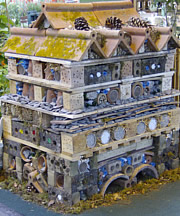Wild Garden Must Haves
If worms live a a wormery where do bugs live?

If you want a haven for wild life in your garden Mick Lavelle has ten ‘must haves’ for you to incorporate. This picture of a wildlife palace from the RSPB archive shows how to create food for birds by protecting insects – see construction details below.
Wildlife Shelters
- Log piles mimic fallen trees and provide shelter for wood boring beetles insects and amphibians.
- Hedgehogs need shelter in daytime and for hibernation. A Habitat stack can provide these if you create a mixed environment with a wood pallet basement followed by a brick pile and layers of tiles, rubble, twigs and logs.
- Leaf piles are usually rich in overwintering insects and form a loose structure for lots of wildlife.
- Bee and Bumblebee boxes can be as simple as bundles of open ended garden canes to provide a resting spot for Bees.
- Rock piles provide nooks and crannies for shelter and security. A mixed herediment will offer the best overall shelter with a bit of everything for lots of creatures
Wildlife Feeding Environments
- Wildflowers and grasses provide seeds as food and ‘escape cover’ for amphibians moving from a pond.
- Bird feeders are more commonplace than ever but make sure they are filled with appropriate food and kept clean.
- A clump of nettles provides food for leaf eating caterpillars and nectar for other insects.
- A pond should be at least 18 inches deep to prevent over heating. It provides drink, food and a living space.
- If space permits a bog garden of wet mud will be a habitat for invertebrates and provide mud for nesting swallows and swifts
“Gardeners’ World”: 101 Ideas for a Wildlife-friendly Garden

Make your own wildlife stack
This incredible 5-star luxury wildlife hotel is easy to make. You will be surprised at how many of the materials you already have lying around your home and garden – now all you need is a steady hand to pile them up! You can make your stack as large or as small as you wish, the only limitations are your imagination.
You will need some or all of the following:
Pallets or strips of wood, Corrugated cardboard, Straw, Plant pots, Tiles, Roofing felt ,Plastic water pipes of varying diameter, Ceramic pipes, Poster tubes, Drinking straws Stones, Hollow bamboo garden canes, Dead hollow stems cut from herbaceous plants
Pithy or hollow lengths of stem cut from shrubs, Bricks and concrete blocks with holes, Pine cones, Logs and Moss.
Choose a level, steady site in the sunlight or light shade. Arrange the bricks on the ground to provide crevices for amphibians, then put a wooden pallet or strips of wood across the top. Stuff some of the pallet with straw, which will provide nesting sites for ladybirds and the other half with small, thin twigs to provide shelter for larger insects. Place another pallet across the top and repeat. Logs, straws, and pine cones will provide extra homes for all sorts of insects.
Attach some roofing felt or polythene to keep the stack dry and make the top layer from whatever you think looks best.
Courtesy of the RSPB mentioned above
2 thoughts on “Wild Garden Must Haves”
Comments are closed.